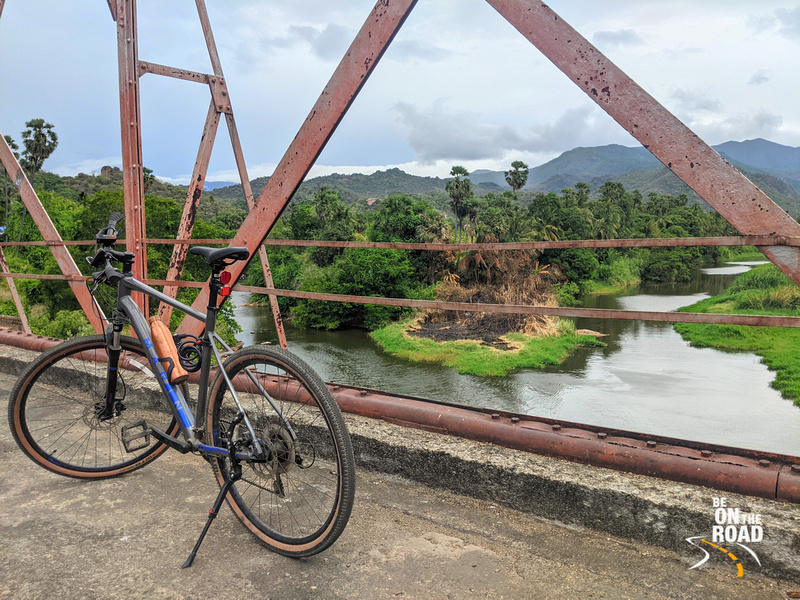
Mountain biking is a thrilling and physically demanding sport, requiring skills, stamina, and the right gear. In this post-modern age, mountain bike accessories have emerged, enhancing riding experience and safety.
Modern cycling accessories have become sophisticated and designed to improve safety, performance, and convenience. These devices range from GPS units to specialized clothing and protective gear. Whether a novice or a veteran, contemporary mountain bikers must appropriately equip themselves to maximize their mountain biking experience. Here, we will delve into the must-have mountain bike accessories for the modern cyclist.
Essential accessories
Here are some must-have mountain bike accessories for the modern cyclist:
Helmets

When it comes to engaging in any sporting activity, safety should always be the top priority, and this holds for mountain biking as well. Wearing helmets designed explicitly for this purpose is crucial to ensure maximum protection. These helmets provide the necessary safety measures and come equipped with additional features. For instance, modern helmets often include integrated lights, allowing bikers to have enhanced visibility during low-light conditions.
Some helmets are designed with action camera mounts, enabling riders to capture their thrilling biking adventures. Additionally, certain helmets incorporate MIPS (Multi-directional Impact Protection System) technology, which offers an extra layer of safety by reducing rotational forces in the event of an impact. By investing in a high-quality helmet, mountain bikers can enjoy their rides with peace of mind, knowing they have taken the necessary precautions for their safety.
Hydration packs
Proper hydration is crucial for any physical activity, especially when it comes to demanding sports like mountain biking. Hydration packs are the perfect solution to stay hydrated throughout those long rides. These packs are designed with a bladder that can hold a substantial amount of water, allowing you to quench your thirst without having to stop and search for a water source.
With a convenient tube attached, you can easily sip on water while on the move, ensuring you maintain optimal hydration levels and perform at your best. Whether tackling rugged trails or embarking on a marathon ride, a hydration pack is essential to keep you fuelled and ready to conquer the mountains.
GPS bike computers

A GPS bike computer is an essential and invaluable device for the modern cyclist. It provides necessary navigation assistance and many advanced features that enhance the riding experience. With its precise satellite tracking system, this device helps riders effortlessly navigate through trails, ensuring they never lose their way. Moreover, the GPS bike computer enables cyclists to monitor their speed, distance, and elevation in real time, fine-tuning their performance and pushing their limits.
This innovative device goes beyond just tracking and monitoring. After every ride, it provides riders with a comprehensive performance analysis, delivering valuable insights and data-driven recommendations for improvement. From analysing cadence and heart rate to evaluating power output and pedal efficiency, the GPS bike computer offers a detailed breakdown of every ride aspect, empowering cyclists to optimize their training and achieve their goals.
In addition to its performance-enhancing features, modern GPS computers offer seamless smartphone connectivity. Wirelessly connecting to your phone lets you receive notifications and messages and even take calls directly on your device, ensuring you stay connected while on the go. Whether receiving important updates or staying in touch with loved ones, the GPS bike computer keeps you connected without compromising your ride.
Bike lights

Mountain bikers frequently riding in low light conditions need reliable bike lights to ensure safety. Fortunately, modern bike lights have evolved to be lightweight, compact, and rechargeable, making them an essential accessory for any night rider.
These advanced lights offer varying brightness levels, allowing bikers to adjust the intensity to suit different riding conditions, whether navigating dimly lit trails or cruising on well-lit roads. With these innovative features, riders can confidently explore the thrilling world of night biking while staying visible and in control.
Protective clothing

Modern protective clothing is designed to provide the utmost comfort, enhance performance, and ensure the rider's safety. This comprehensive gear encompasses various elements, such as strategically padded shorts to minimize discomfort during long rides, moisture-wicking jerseys that keep the rider cool and dry, specialized bike gloves for winter conditions, and high-quality glasses to shield against dust particles and harmful UV rays.
In addition to a helmet and protective clothing, additional body protection gear is highly recommended for mountain biking, especially when tackling challenging trails. This gear includes knee pads, elbow pads, and even chest protectors. The modern versions of these accessories are designed to be lightweight and breathable, ensuring safety without compromising comfort or mobility. Investing in high-quality body protection gear can significantly reduce the risk of injuries while allowing you to enjoy the thrill of mountain biking confidently.
Bike repair tools
Every biker should equate themselves with a comprehensive and reliable bike repair kit to embark on a thrilling trail adventure. This essential kit must include a versatile multi-tool with hex keys, allowing for precise adjustments and repairs. Additionally, having tire levers, a patch kit, and a portable bike pump are indispensable tools for tackling unexpected situations like a pesky punctured tire or a loose screw.
Final thoughts

Mountain biking in the modern age requires more than just a bike and a trail. It demands the right accessories to ensure safety, enhance performance, and maximize the riding experience. While the market offers many products, the modern cyclist's basic kit should comprise a helmet, hydration pack, GPS bike computer, bike lights, and protective clothing. Investing in these essential accessories will help you enjoy the thrill of outdoor mountain biking while staying safe and competitive.
Travel blog of an Indian traveler living his dream of experiencing the world and inspiring others to live their travel dream. Focus areas are travel and visa tips, destination guides, experiential travel stories and traveling as a vegetarian.
Tuesday, December 19, 2023
Ride in style: Essential mountain bike accessories for the modern cyclist
Thursday, November 30, 2023
Rustic Nature Views from my Village Home

It is that time of the year when the North East monsoon is in full effect at my village. The village and its surroundings are dressed up in lush green. The dams are getting full. The waterfalls are gushing with water and the rivers and canals have swollen in size. And you almost always wake up to the blissful cacophony of birds and that includes a few peacocks that have made my terrace and my neighbour’s terraces as its home.
When we get our North East monsoon rains, it almost always pours and getting out in the rains is tough, though the views are surreal. Sometimes, I did get drenched in the rains and ended up catching a cold. Unlike the South West monsoon, the rains of the North East monsoon are a bit cooler and it is best to avoid getting wet in the rains.
I thought why not share these village scenes with you during the monsoon season. So here goes the rustic nature views from my village home as promised in my earlier article about me moving my base to the village of Kallidaikurichi in South Tamil Nadu. More pictures and stories in my subsequent articles.
Above photo: This view from my terrace shows you the Chidambareswar Shiva temple, the Kannadigan canal (we call it vaykaal in the local parlance), the paddy fields and the cloud covered Western Ghats in the background along with the golden colours of sunset.

Above photo: Paddy turns golden. The main crop grown here, these paddy fields are getting ready for harvest. You can see the Western Ghat mountain ranges in the background.
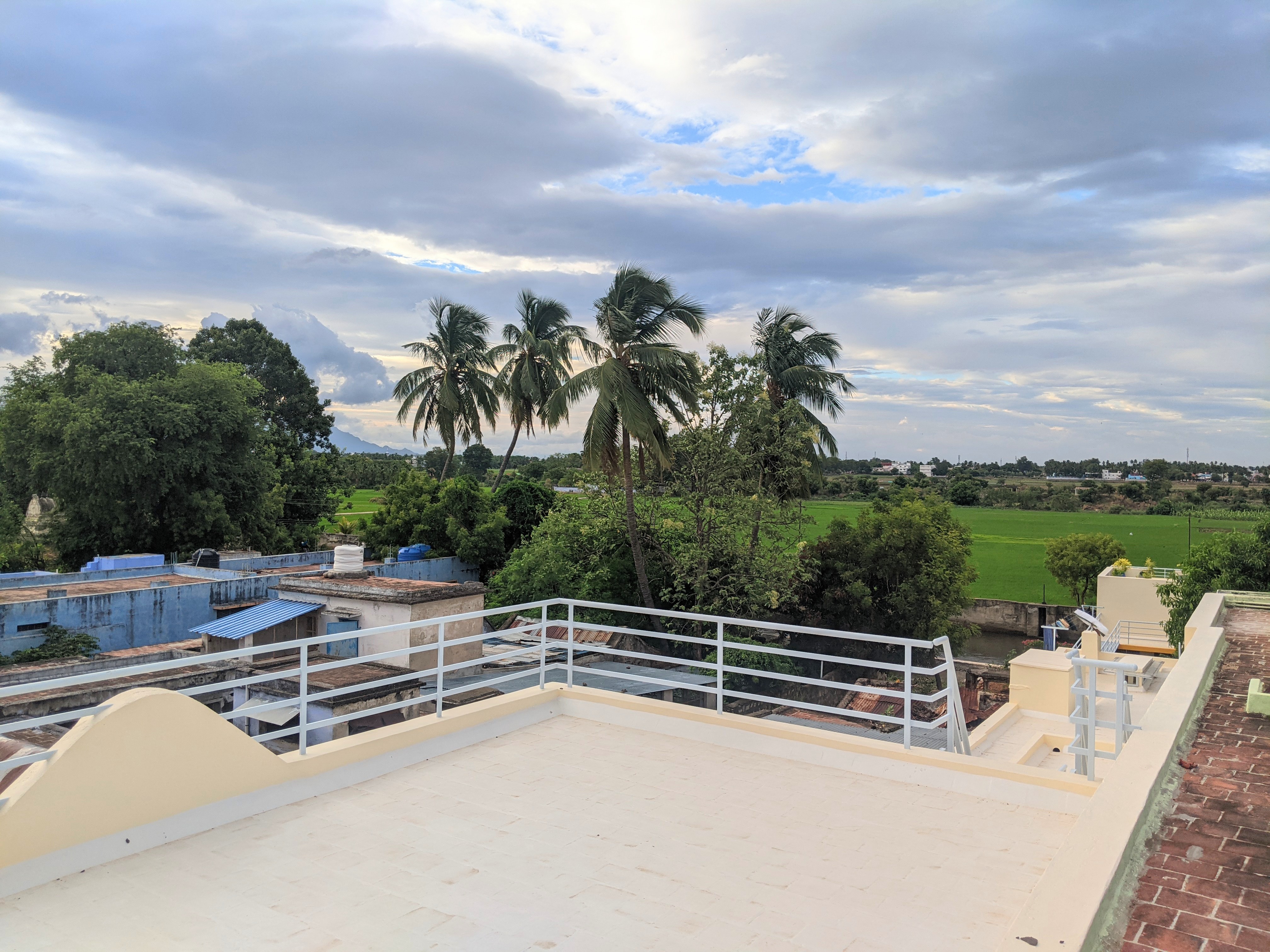
Above photo: Gorgeous green view of paddy fields, coconut trees, Western Ghat mountains and the town of Ambasamudram in the yonder.
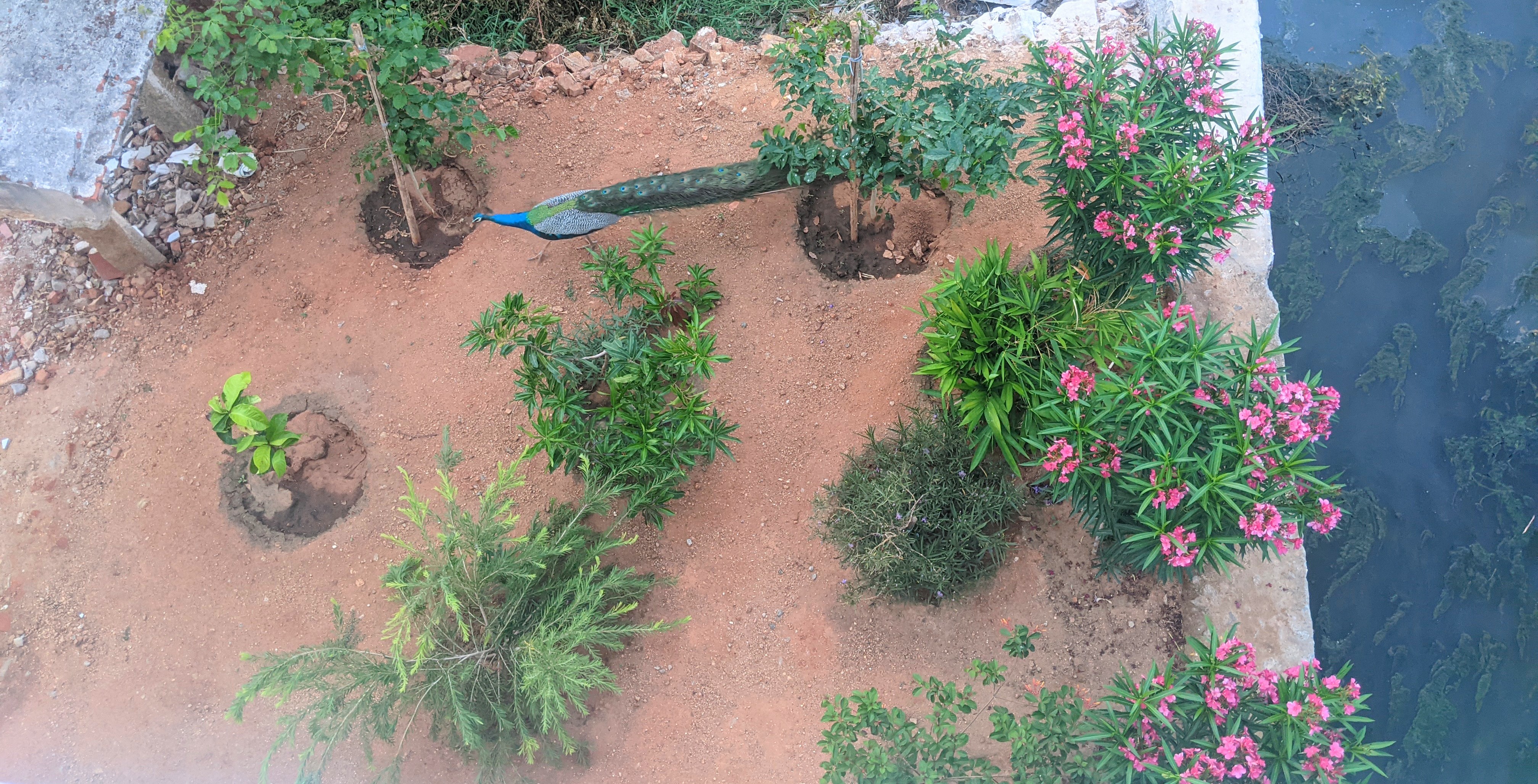
Above photo: A peacock struts its stuff at my home garden. He is a daily visitor and I almost always wake up to his calls.
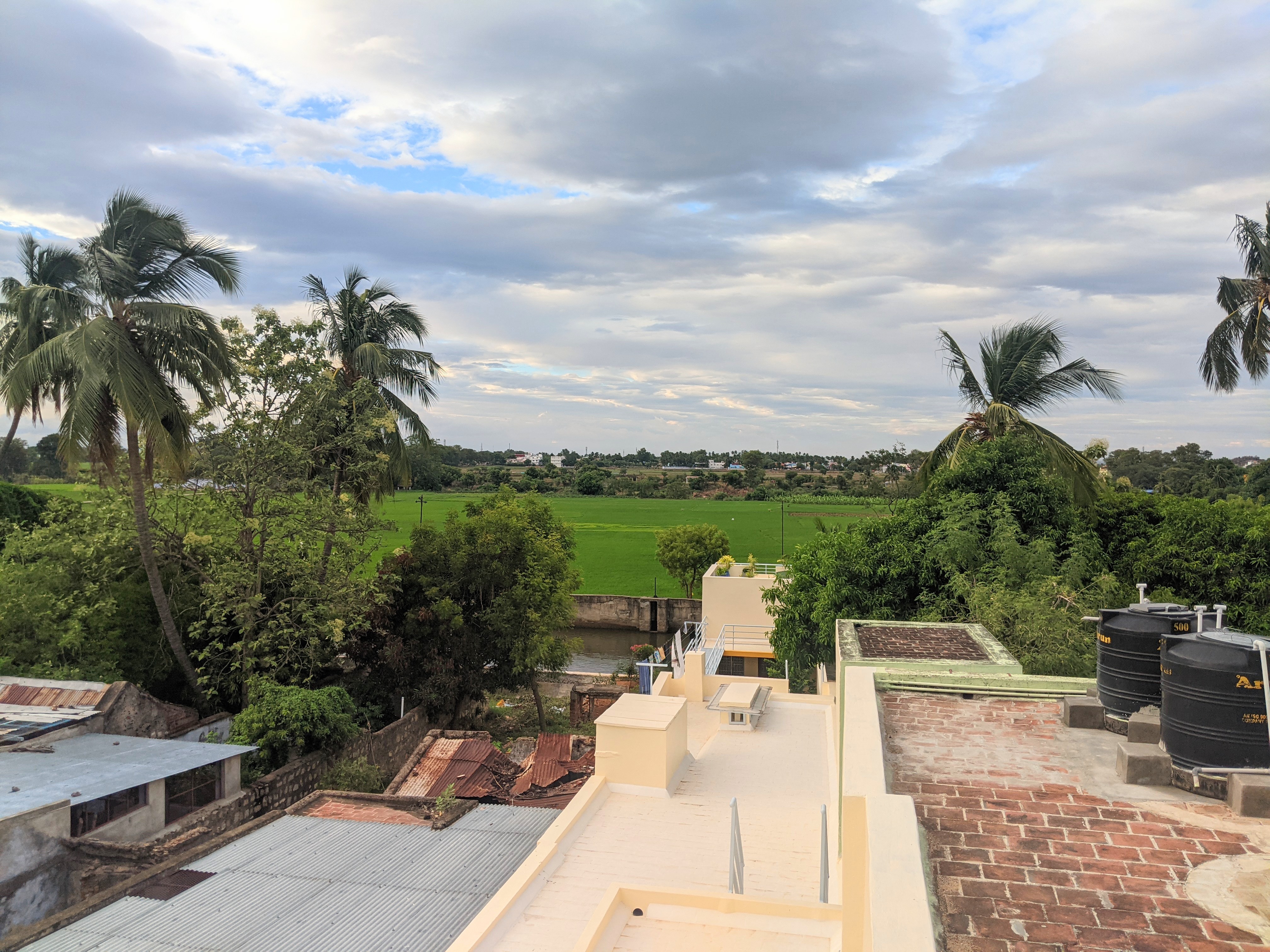
Above photo: My terrace offers a 230 degree view of the mountains, views of the Kannadigan canal, the paddy fields, trees in the gardens of my neighbours, the agraharam streets, the local temples and more.
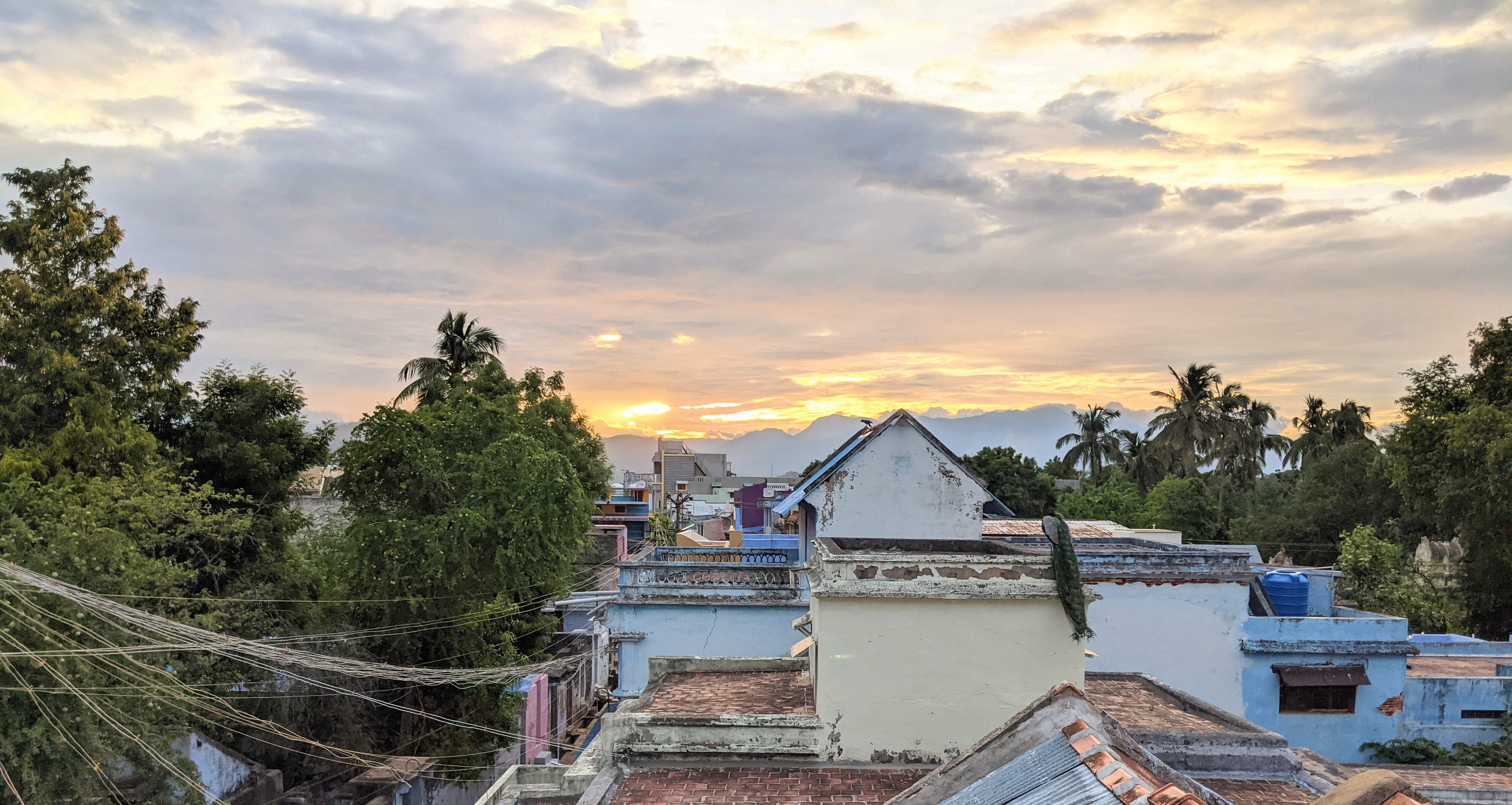
Above photo: This is a sunset view from my top terrace. The Western Ghats of Kalakad Mundanthurai Tiger Reserve are in the West, the terraces of my neighbours are in the foreground and somewhere between the two is this peacock that climbs to a high point every evening

Above photo: This view is from the back of my village home. My home back door opens into the canal and behind that is the paddy field that is bathed in the golden rays of the evening sun. Further beyond that is the Thamirabharani river, which is not visible in this photo. And further beyond that is the village of Ambasamudram, which is visible through some tiny buildings.
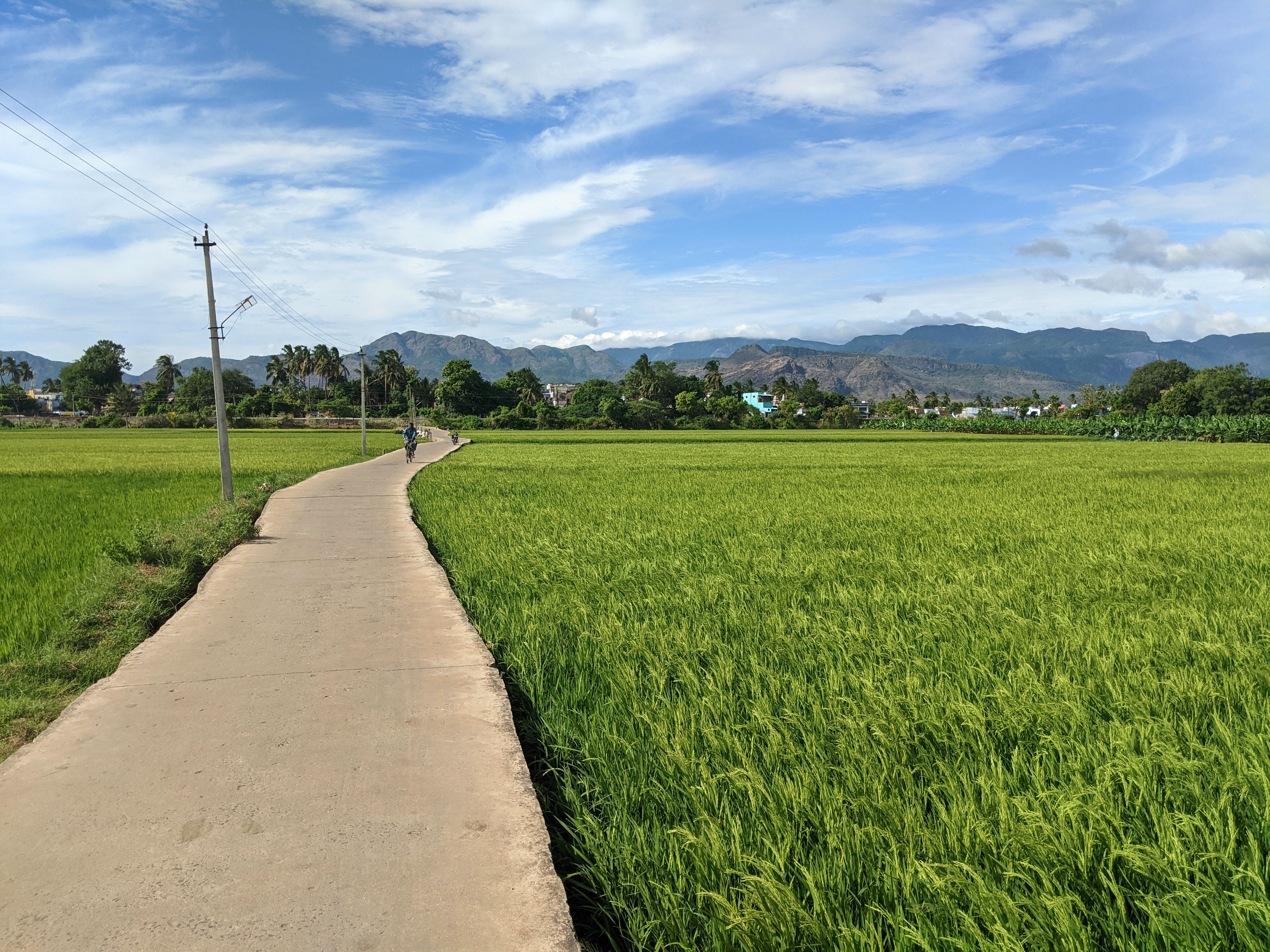
Above photo: This is the concrete road that connects my village home with the Thamirabharani river. To your left and right are swaying golden paddy fields and surrounding you on three sides are the tall mountains of the Western Ghats, especially the ones in the Manimuthar and Papanasam range.
Friday, November 17, 2023
Anchorage Foodie Adventures: Discovering Local Cuisine and Dining Hotspots

Anchorage, Alaska is a stunning bucket list destination. Known as the gateway to the 49th state, this charming metropolis is perfectly situated on the edge of a vast, majestic, untamed wilderness, and the ideal base camp for exploring the wild tundra, frozen glaciers, and dramatic mountain ranges of the Last Frontier.
While celebrated for its access to breath taking landscapes and extreme outdoor adventures, Anchorage is also emerging as a centre of food culture. The Alaskan foodie scene is an increasingly energetic and dynamic one, taking advantage of the abundance of fresh, wild produce and amazing local flavours to showcase the ingenuity and creativity of this fascinating region.
So if you are living the adventure with an Alaskan cruise and want to explore the remarkable flavours that the state has to offer, Anchorage is a fantastic place to start. Here are some of the best dining hotspots and regional culinary highlights to explore on a foodie adventure in Anchorage.
Wild Salmon Delights
Wild salmon is one of Alaska’s finest delicacies, and Anchorage is probably the best place to try it. Everywhere you turn in the city you will discover local restaurants serving up delectable dishes with freshly-caught salmon, in all sorts of styles from cured and hot-smoked to grilled and baked. The richness and unique flavour of the various species of wild-caught Alaskan salmon is incomparable, and a must-try for any foodie visitors.
Local Breweries and Alehouses

Alaska has long been a huge player in the US craft beer scene and Anchorage’s breweries and alehouses are thriving. With a diverse range of interesting, inventive, and eclectic brews in pubs, bars, and taprooms across the city, there’s no excuse not to quench your thirst when in town. Highlights of the brewing scene include local favourite The Midnight Sun Brewing Company, whose taproom is a cosy haven of warmth and good times, and 49th State Brewing, a lively brewpub with a rooftop patio doling out creative bar bites & house made ales.
Indigenous Alaskan Cuisine
Traditional indigenous Alaskan cuisine is an acquired taste, but one well worth trying. Places like the Alaska Native Heritage Centre offer the opportunity to try dishes that have sustained native communities for generations and provide a unique insight into the way of life of the indigenous Alaskan peoples. From salmon stew and smoked fish to fry bread, muktuk, and Eskimo ice cream (akutaq), trying the traditional food is a great way to connect with the cultural roots of Alaska.
Seafood Shacks and Oyster Bars

Anchorage is, as the name suggests, set right on the ocean. As a result, seafood is a huge part of its culinary offering. From fresh halibut to oysters, the harvest of the sea is a must-try in this glorious port city. Head to Sourdough Mining Company to try their seafood platter or check out the Bubbly Mermaid Oyster Bar, a cosy spot famous for its fresh oysters.
Sweet Treats and Bakeries
When the weather is cold and wet, nothing hits the spot like a little freshly baked goodness. Anchorage is full of charming bakeries where you can satisfy your sweet tooth, like Fire Island Rustic Bakehouse or the Flying Dutchman European Pastry Shop.
The culinary scene in Anchorage is a fascinating and eclectic blend of tradition, innovation, and the freshest produce the wild landscape of Alaska has to offer. From succulent salmon and amazing seafood to indigenous curiosities and amazing craft brews, there is something to satisfy every palate, with interesting, exciting, and unexpected flavours in every dish. Anchorage is the perfect showcase for the creativity of Alaska and its food scene is one to be savoured.
Note: The pictures in this article are courtesy of wikipedia.org and have been borrowed under the Creative Commons license. Each photograph has been linked to its host page on wikipedia.org.
Tuesday, November 14, 2023
Thiruparappu Falls: Gorgeous Monsoon Spectacle near Kanyakumari
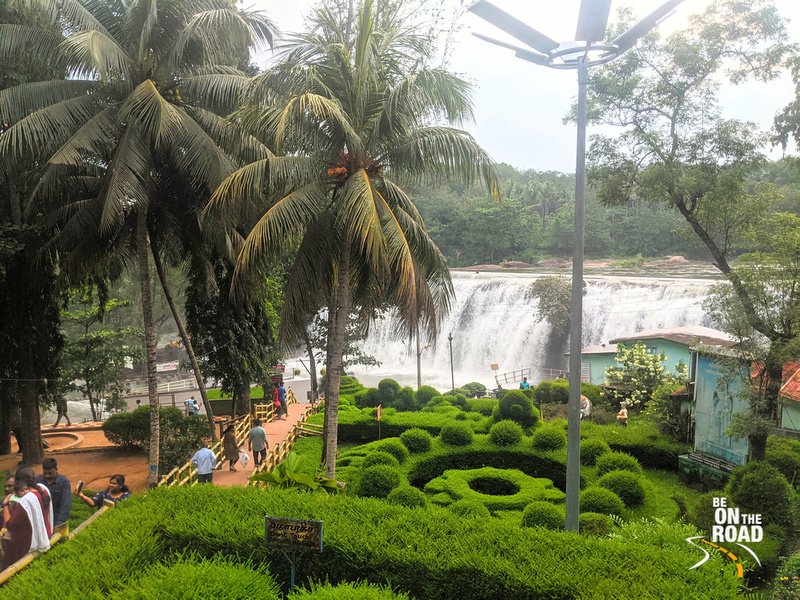
It is a stunning 50 feet high and 300 feet wide waterfall that is surrounded by lush greenery. It is a fabulous place for both adults and kids to enjoy a refreshing waterfall bath and a swimming picnic location downstream. It is also home to a 10th century Chola era Mahadeva temple. I am talking about the Thiruparappu falls on the Kodayar river about 15 kilometers downstream of the Pechiparai Dam.
Located near the town of Kulsekharam, this waterfall is a popular tourist attraction near Kanyakumari, especially among the locals and offers a gorgeous spectacle during the monsoons when the waterfall gushes with copious amounts of water. It is the kind of place where you can get a nice massage under the waterfall, laze around with your kids in the natural swimming pools, enjoy a hot cup of chukku coffee to get your body heat going and enjoy a quiet picnic lunch on the banks of the Kodayar river.
The herbal waters flowing from the medicinal forests in the Western Ghats, the green environment, the ancient Shiva temple and a rustic atmosphere are all icing on the cake.

If you are visiting Kanyakumari or Thiruvananthapuram, don’t miss to visit this gorgeous monsoon spectacle in the Kanyakumari district of Tamil Nadu. It is an ideal waterfall location to go with family and friends. It is safe, has decent access to food and there is hardly any walking to reach the waterfall from the parking lot. I can’t stop recommending this offbeat waterfall destination of Tamil Nadu.

Where to eat:
The stalls near the waterfall entrance serve some basic food like bajji, biscuits, tea and coffee that is available at all times. There are a few restaurants that serve simple meals, but one needs to inform in advance.
For better food options, head to Nagercoil city or any good restaurants on the Nagercoil – Kanyakumari – Thiruvananthapuram highway.
Where to stay:
There are a few guest houses and hotels where one can stay near the waterfall. Slightly more luxurious places can be found near Chittar Dam, about 8 kms away.
For better food and accommodation, head to the cities of Nagercoil, Kanyakumari or Thiruvananthapuram where you can find properties catering to all kinds of budgets.

Distance to Kanyakumari: 62 kms
Nearest airport: Thiruvananthapuram (56 kms away)
Nearest railway and bus station: Nagercoil (38 kms away)

Thiruparappu falls entrance fees:
INR 5 per person
INR 30 per camera
INR 30 per vehicle parking

Best time to visit:
The best months to visit would be the rainy months from June to January as that is when there would be good amount of water to enjoy a refreshing bath and a swim. However, the waterfall can be closed during heavy rains to protect the people. Do check with local authorities or online about waterfall status.

Timings:
Thiruparappu Falls is open all year round from 7 AM to 6 PM

Other nearby tourist attractions:
1) Mathoor Aqueduct and Hanging Bridge: An offbeat wonder nestled in the mountains near Kanyakumari
2) Padmanabhapuram Palace: 17th century Travancore era palace
3) Thanumalayan Temple, Suchindram: Also known as Sthanumalayan temple, it is one of the 108 Shiva temples revered by the Kerala Hindu culture
4) Kanyakumari: The land’s end that is home to beautiful temples, gorgeous beaches, stunning rock cut memorials and many forts
5) Poovar Island: A beautiful mix of serene backwaters (emerald), pristine beach (golden), majestic Western Ghats (green), swaying palms (green) and blue waters of the Arabian Sea
6) Thiruvananthapuram: The capital of Kerala home to the richest temple of India – Padmanabha Swamy Temple, gorgeous beaches and a lovely green metropolis
Monday, November 06, 2023
Mathoor Aqueduct and Hanging Bridge: An offbeat wonder nestled in the mountains near Kanyakumari
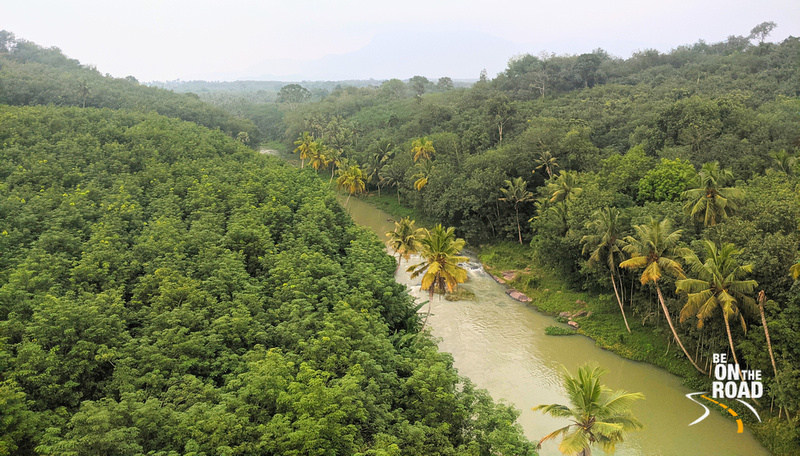
It is one of the largest aqueducts in Asia. It is also the tallest and longest trough bridge in Asia. It is an engineering marvel and a tourist’s delight. It offers a spellbinding vista from the top and a great river side picnic location at its bottom. I am talking about the Mathoor Aqueduct and hanging bridge (locally known as Mathoor Thottipalam) that is located in the Kanyakumari district of Tamil Nadu.
The Mathoor aqueduct and hanging bridge was built in 1966 under the leadership of the former chief minister of Tamil Nadu, K. Kamaraj, as a drought relief measure over the river Pahrali to carry water for irrigation from an elevated level of one hill to another. This 115 feet high and 390 metre long hanging trough is not only an engineering beauty, but it is also a popular tourist destination for the locals due to its scenic location and calm surroundings.

In spite of its popularity amongst the local people, it is fairly unknown to the outside world and that is what makes this place an offbeat wonder. Nestled in the hills near Kanyakumari, the entire area is lush green and is surrounded by the Western Ghats. Armed with a 5 rupee ticket and some freshly salted and spiced locally grown mango, cucumber, pineapple or pomelo that is sold at the shops near the ticket counter, your journey begins next to the water body that seems to be flowing to the other side of the hill. There are 2 routes that you can take here. One is a flight of steps that lead you all the way down to the Pahrali river where you can swim in the water and relax doing some fin in the water. The other route is straight over the hanging bridge. On one side of the pathway is your walking path and on the other side is the water in the aqueduct going slowly down to the other side of the hill. As you keep walking towards the centre of the aqueduct, you cannot stop staring at the vast expanse of greenery, the rolling hills in the background and the meandering Pahrali river flowing below. You can go further all the way till the other hill and walk down the flight of steps to the other bank of the Pahrali river.
The entire walk can feel adventurous at times owing to the narrow walkway, the extreme height and the strong gusts of wind that blow through here quite regularly.
Unfortunately for me, I arrived very close to the closing time and hence the surroundings were fairly dark and I literally had to run through the entire bridge before I was engulfed in darkness. Of what I got to see, this place is fantastic for a motorcycling holiday, an offbeat nature location and a riverside day out with family and/or friends. I would love to return here hopefully in the near future and this time preferably in the morning hours so that I can explore the area at leisure. I definitely recommend this place with multiple thumbs up!

Best time to visit: October to March as this is when the weather is pleasant, there is water in the river and the surroundings are lush.
Distance to Kanyakumari: 52 kms
Distance to Trivandrum: 61 kms
Nearest railway station: Nagercoil Junction, 30 kms away
Nearest airport: Thiruvananthapuram Airport, 65 kms away
Timings: Mathoor Aqueduct is open all year round from 6 AM to 6 PM.

Other nearby tourist attractions:
1) Padmanabhapuram palace: 17th century Travancore era palace
2) Thiruparappu Falls: A gorgeous waterfall perfect for bathing and a relaxed day out
3) Thanumalayan Temple, Suchindram: Also known as Sthanumalayan temple, it is one of the 108 Shiva temples revered by the Kerala Hindu culture
4) Kanyakumari: The land’s end that is home to beautiful temples, gorgeous beaches, stunning rock cut memorials and many forts.
5) Poovar Island: A beautiful mix of serene backwaters (emerald), pristine beach (golden), majestic Western Ghats (green), swaying palms (green) and blue waters of the Arabian Sea.
6) Thiruvananthapuram: The capital of Kerala home to the richest temple of India - Padmanabha Swamy Temple, gorgeous beaches and a lovely green metropolis
Friday, October 20, 2023
Kallidaikurichi Adi Varaha Temple Chariot Festival: Grand Cultural Spectacle in Rural Tamil Nadu

The Rath Yatra or the Chariot Festival is one of the best temple traditions to see in India. The Rath Yatra is actually the main event of this festival and there are key events that precede and succeed this temple chariot festival. I got to see one grand cultural spectacle in entirety at a traditional village in rural Tamil Nadu. This is the temple chariot festival of Kallidaikurichi’s Adi Varaha Perumal temple that spans 9 days and is locally called as Brahmotsavam.
Held in the Tamil month of Chithirai (April 14 to May 15), the annual festival of Brahmotsavam is the grandest festival of the temple and the entire temple and the agraharam streets surrounding the temple wear a festive look for 9 days. This Brahmotsavam is a great program of festivals extending over nine days. During this period, every morning and evening, Lord Adi Varaha perumal is taken out seated on a huge vehicle and carried through the different agraharam streets of Kallidaikurichi.

The commencement of the utsavam is marked by a ceremony called the Dhwajarohanam, or the hoisting of the flag. Prior to every start, holy water from the nearby Thamirabharani river is brought to the temple for all ablution rituals. This is followed by Sankalpam (holy declaration) , abhishekham (holy bathing), alangaram (holy decoration) and vahana seva. In this vahana seva, the lord is taken in a procession around the streets of Kallidaikurichi on different vahanas (vehicles). Each vahana has its own significance and conveys the lord’s message in its own way.
From the first day of the Brahmotsavam to the ninth day, the lord takes to the different streets of Kallidaikurichi every morning and evening in his different vahanams. Below is a day by day breakdown of the different vahanams and their true meaning. As the lord visits each street in his different vahanams, the devotees adorn the fronts of their homes with colourful homams and offer coconuts, fruits and betel leaves to the lord while admiring his new look and seeking his blessings.
Day 1: Sesha vahanam
The meaning of Sesha is ‘to serve’. Adi Sesha is a thousand-headed serpent, on whom Lord Maha Vishnu rests in his abode, Vaikuntam.
Day 2: Hamsa vahanam
Hamsa or Swan means ‘pure’. Hamsa is believed to have a high intellectual capability, and can distinguish the good from bad. It is for this very reason that Lord Brahma uses Hamsa not only as his vehicle, but also to chant the vedas (The Vedas are believed to have emanated from the soul of Vishnu).
Night 2: Aswa vahanam
Horses form one of the four wings (ratha, gaja, turanga and pada) of the military forces in the ancient times. Aswam, a symbol of energy, means ‘one who runs fast). Lord Vishnu travels on a horse when he goes for paruveta. According to Hindu mythology, the horse was born along with Sri Mahalakshmi, Airavatham and Amritham during Sheerasagaramadhanam.
Day 3: Simha vahanam
Simha (lion) is a symbol of regality and power. According to the Bhagavad Gita, the lord is the Simha among animals (mriganamcha mrigandroham). The Lord is also called Hari (which in turn means Simha) and Hari sits on Simha. In other words, we have the phenomenon of the Lord sitting on himself.
Night 3: Mutayalapandiri vahanam
In the night Oonjal seva is conducted. The deities then ride under a pearl canopy. Mutyam (pearl) is a symbol of purity and royalty.
Day 4: Kalpavriksha vahanam
Kalpavriksham is a tree that is believed to grant boons and fulfil wishes. The vehicle shaped like the Kalpavriksham signifies that the Lord grants boons and fulfils the wishes of his devotees.
Night 4: Sarvabhoopala vahanam
Sarvabhoopala means ‘all the kings of mother earth’. According to the Hindu religion, kings, like Lord Vishnu, should always protect their people (na vishnuhu prithivi patihi).

Day 5: Mohini Avatarotsavam on palaku (palanquin)
According to legend, the devatas and asuras performed Ksheerasagaramandhanam that resulted in amrit (nectar which when consumed grants immortality) and other sacred qualities. The devatas and the asuras fought for the possession of the Amrit. Lord Vishnu then assumed the form of Mohini (a beautiful woman) and procured the Amrit for the devatas.
Night 5: Garuda vahanam
According to the ancient Hindu texts, Garuda, the king of birds, is a replica of the Vedas (vedatma vihamgeswara), while Lord Vishnu is the God of the Vedas. Therefore, the lord sees himself in Garuda. In the Vaishnava Puranas, Garuda is called periyatiruvadi, meaning the first devotee. Therefore, Lord Vishnu selected Garuda as his vehicle for the most important day of the Brahmotsavam. Garuda vahanam is the greatest of all the vahanams.
Day 6: Hanumad vahanam
Hanuman is one of the greatest devotees of Sri Rama, an incarnation of Lord Vishnu. Hanuman served the lord so faithfully that even the lord could not thank Hanuman enough. Devotees believe that they are indeed blessed if they catch a glimpse of the Lord on Hanumad vahanam.
Night 6: Gaja vahanam
Gajam (elephant) is also called the samajam (born from Sama Veda). It symbolizes wealth (gajamtam aishvaryam). It also symbolizes the Airavatam – the vehicle of Indra, the head of the heavens in Hindu mythology). It can also be attributed to the elephant in Gajendramoksham (story from Mahabhaghavatam), which is saved from a crocodile by Lord Vishnu.
Day 7: Suryaprabha vahanam
Surya (the Sun), the son of Aditi, is another form of Lord Vishnu (Surya Narayana). Hindu mythology supports the heliocentric theory and believes that Lord Vishnu is the centre of the universe (dhyassada savitrumandala madhyavarthi).
Night 7: Chandraprabha vahanam
Chandra, means the Moon, which is considered cool and pleasant. According to Hindu mythology, Chandra is the commander of the mind (chandrama manaso jataha). He is also the king of aushadham (medicine). It is believed that riding in the Chandraprabha vahanam is a soothing experience for the lord. The Lord’s contentment will bring peace to devotees’ minds and result in a good crop.
Day 8: Big Rath Yatra
On the penultimate day, Rathotsavam is celebrated, in which the Lord is seated in a ratham (chariot) and taken in a procession in the morning. The route taken by the Lord is called the Rathaveedhi and it does a circumambulation of the Adi Varaha Perumal temple. Tens of thousands of devotees come early in the morning to offer their prayers to the lord and then hold on to the chains of the chariot to pull it through the Rathaveedhi. It is believed that those who witness Rathotsavam will not be reborn (rathotsavam kesavam dristva punarjanma na vidyate).
The idols of Daruka (the charioteer of Lord Sri Krishna) and the four horses (Saibhyam, Sugreevam, Meghapushpam and Valahakam) are placed before the decorated idols of the Lord and his consorts. This symbolizes that the lord’s charioteer is driving the chariot.
As the Ratham goes around the Rathaveedhi, one can hear chants of ‘Govinda! Govinda! and Adi Varaha! Adia Varaha!. The energy is high and devotees offer food and drinks to the people pulling the chariot. Ambulances and police are on standby in case of any emergencies. It takes close to three hours for the Rathotsavam from start of its journey to end. People from nearby villages, nearby cities and even families of people hailing from Kallidaikurichi, but living all over the world, arrive to see this Rathotsavam from close quarters. The Ratha is colourful, the energy is infectious and the festival a grand cultural spectacle.
In the evening, the lord and his consorts are taken back into the temple amidst full fanfare.
Day 9: Last Day
On the last day, Pallaki seva and Chakrasnanam mahotsavam is performed in the morning. Water from the Thamirabharani river is brought to the temple and the processional idols are bathed with it. Abhisekham, alangaram and mahamangalarti is done. Then the garuda flag is lowered. This signifies the end of the Brahmotsavam festival.

It will be a dream come true if you can experience all the nine days of the Brahmotsavam up close. The rich heritage, the amazing culture, the colourful vehicles, the powerful hymns and the infectious energy can all be experienced at once. And to top it all, you get to seek the lord’s blessings on all the days. If you cannot attend all days, then you should definitely make time for the Big Rath Yatra or the Rathotsavam, the grand annual festival of the Adi Varaha Perumal temple.
How to reach there:
The nearest airport would be Tuticorin airport, located 75 kilometres away. Tuticorin has daily flights connecting it with Bangalore and Chennai. The other nearest airports are Madurai (180 kms away) and Thiruvananthapuram (140 kms away).
The nearest large railway station is Tirunelveli junction, which is well connected with the rest of the country. The nearest railway station is Kallidaikurichi itself, but only local passenger trains stop here.
The nearest large bus station is Tirunelveli. Regular buses ply between Tirunelveli and Kallidaikurichi throughout the day and night. Kallidaikurichi is 35 kms from Tirunelveli and a typical bus ride takes about 60 to 70 minutes.

When does this festival happen:
The Adi Varaha temple chariot festival takes place in the Chithirai month (between April 14 and May 15). The festivities span 10-12 days, with each day marked for a different activity. The big rath yatra takes place on the final day of all the festivities.

Where to stay:
Kallidaikurichi is the kind of place where you should stay at one of the agraharam homes. It will allow you to experience the true culture of this village. You could either stay with any of your local friends in their homes, at any local guest houses or at airbnbs.
If you prefer hotels, you can try the modest Bhaskar Lodge at Kallidaikurichi and the slightly better Hotel Ambai Grand at Ambasamudram. For higher quality hotels, you will have to head to Tirunelveli, about 35 kms away.
If you prefer staying in nature, try any of the forest bungalows located inside Kalakad Mundanthurai Tiger Reserve or the farm stays or resorts near Courtallam (50 kms away).

Where to eat:
Kallidaikurichi has a few places to eat like Kannan mess where you can find tiffin items like idli, vada and dosa. For something more elaborate, try Hotel Ramanas or Hotel Gauri Shankar at Ambasamudram, two kilometers away.
If you are staying at a guest house with an in-house kitchen, then you are all set for food.
If you are staying at a house or in an Airbnb, you can try the meals and tiffin items of Varaha mess or Delhi mama. They offer a wide variety of choices and food is usually delivered to your door step.

Other famous festivals to see at Kallidaikurichi:
1) Garuda Sevai from the agraharams of Kallidaikurichi
2) Maha Shivaratri
3) Karthigai Deepam
4) Pongal
5) Thiruvatharai

Other nearby tourist attractions:
1) Kallidaikurichi to Manimuthar Dam: A top scenic and rustic cycling route
2) Thamirabharani river at Kallidaikurichi: A great Western Ghat river to take a refreshing bath
3) The hidden gem called Kalakad Mundanthurai Tiger Reserve
4) Kallidaikurichi: The village of the Saaral season
5) Kallidaikurichi Anaicut: Gorgeous picnic spot nestled in the lap of nature
6) 1000 year old Papanasathar Temple at Papanasam: Where you can wash all your sins away
7) Manjolai: The offbeat hill station of Tamil Nadu
8) Mannarkoil Rajagopalaswamy Temple: Magnificent 10th century temple with a Ashtanga vimana

9) Sivasailam temple: 1000 year old temple surrounded by the lush mountains of the Western Ghats
10) Sivasailam: One of the wettest places during the North East monsoon in India
11) Karaiyar Dam: Offbeat wildlife and nature holiday destination in India’s Deep South
12) Courtallam: The herbal bath holiday destination of Tamil Nadu
13) 10th century Kailasanathar temple at Brahmadesam
14) 10th century Valiswara temple at Thiruvaleeswaram
15) Manimuthar Falls: A great forest waterfall
16) Agastyar Falls: A great waterfall to bathe in the Western Ghats
17) Paana Theertham Falls: A hidden waterfall gem of Tamil Nadu
Saturday, October 14, 2023
My Village Home in Kallidaikurichi, Tamil Nadu

It has been a little over a year since I moved my base from Bangalore to my ancestral village of Kallidaikurichi in the Tirunelveli district of Tamil Nadu. I still have my house in Bangalore, but I spend more time in my village home than in my city home.
Kallidaikurichi is the village of my paternal grandmother and it holds a special place in my heart right from my childhood days. I have always been visiting often, especially after my dad’s passing, but it was last year when I started spending a significant amount of time here. The plan was to take care of my grandmother and renovate our ancestral home. I got the opportunity to spend time with my grandmother and take care of her before she moved on at the rich age of 98. Thankfully, my grandmother got to see most of the completed renovation work and I was very thrilled to see the genuine happiness in her eyes. The home is named ‘Akhilandeswari’ in remembrance of my grandmother.
This village home of mine in Kallidaikurichi in India’s deep south is surrounded by the Western Ghat mountains on three sides. There is a Kannadigan canal behind my home and further north is the Thamirabharani river. It is located in the beautiful agraharams that are surrounded by temples on all sides. To my south is the Adi Varaha Perumal temple. To my west is the Ramachandra, Sringeri Sharadamba and Chidambareswarar temples. To my east is the Murugan and Ayyappa temples and to my north is the big Shiva temple on the opposite bank of the Thamirabharani river in Ambasamudram. Royal Enfield, India Cements, Oriental Bank of Commerce and many other notable brands were born in this village. In its hey days, it was a thriving Brahmin settlement and even till date, it is one of the more well maintained agraharams of Tamil Nadu. Such is its popularity that a lot of movies are shot here.
Just 10 kilometers from my village home is the forest check post of the Kalakad Mundanthurai Tiger Reserve, one of the more pristine and lesser known tiger reserves of India. And because of this proximity to the Western Ghats, you are never too far away from waterfalls, dams, mountain vistas and wildlife. In fact, monkeys, langurs, peacocks, more than 50 species of birds, many species of reptiles and oodles of butterflies can be spotted right from the terrace of my village home.
Agriculture is the main source of income for the people living here. Paddy and banana are the main crops here, though a lot of people grow tuber vegetables and brinjal too.
The above picture is in essence the view that I see every day, the culture that I embrace every day and the bright and warm sunshine that bathes the village every day. Yes, this tropical village can get seriously warm at times, but its lush nature, peaceful surroundings, rich culture and friendly people more than compensate for the high temperatures.
Do drop by home for a cup of coffee if you happen to be in the vicinity! And do stay tuned for more photos and more village experiences.
Friday, October 13, 2023
Dubai After Dark: Unforgettable Experiences Await

The modern skyscrapers of Dubai make it the perfect destination for the rich and famous. However, people from all over the world come here to enjoy its many shopping malls, souks, parks, beaches, and much more on a budget too!
There are so many features unique to Dubai alone, such as being the city with the largest suspended aquarium. In the Emirates Mall, you can find a massive indoor skiing arena, and its IMG World of Adventure is the largest theme park in the world!
Complete your Emirates booking to reach Dubai from your country's capital city or any key metro city close to you and enjoy a fun-filled vacation time with your family. It is not just wonderful to explore during the daytime but also at night when it comes alive with glowing lights. Here is a look at some exciting ways to spend your time at night in this bustling city:
1) The best way to enjoy fantastic light effects at night in Dubai is by visiting the Dubai Garden Glow. It has some very interesting optical illusions, which make exploring it so exciting. There are many illuminated, brightly coloured scenes here that are striking, enchanting, and lovely.
2) Make a trip to the world’s tallest building, the Burj Khalifa, right after 6 p.m. Make a trip to its highest floors, from where you can enjoy a panoramic view of the city at night, with surrounding skyscrapers and the city lit up. As you leave the place, you can see the fountain, which glows exotically in many lights and is also the stage for numerous performances.
3) If you love sports, then visiting Dubai’s Dark Padel courts is just what you need. Padel is a new and fast-catching sport that you can best enjoy at night under illuminating neon lights in the play area. Everything gets transformed into such colours, and the sport played in such lighting is exciting and fantastic.
4) In the Dubai Festival City Mall stands a fountain that is the centre stage for fantastic laser light shows every night, which are free to watch. It’s a scene that has impressed many enough to get an entrance into the Guinness World Record twice.
5) Make a trip to the Dubai Fishing Harbour and find the Crystal Clear Watersports Centre to enjoy kayaking at night. You will be kayaking in a glass-bottomed kayak that is lit by beautiful fairy lights. You can also view the impressive skyline at night with all its lights lit up, making a grand scene.
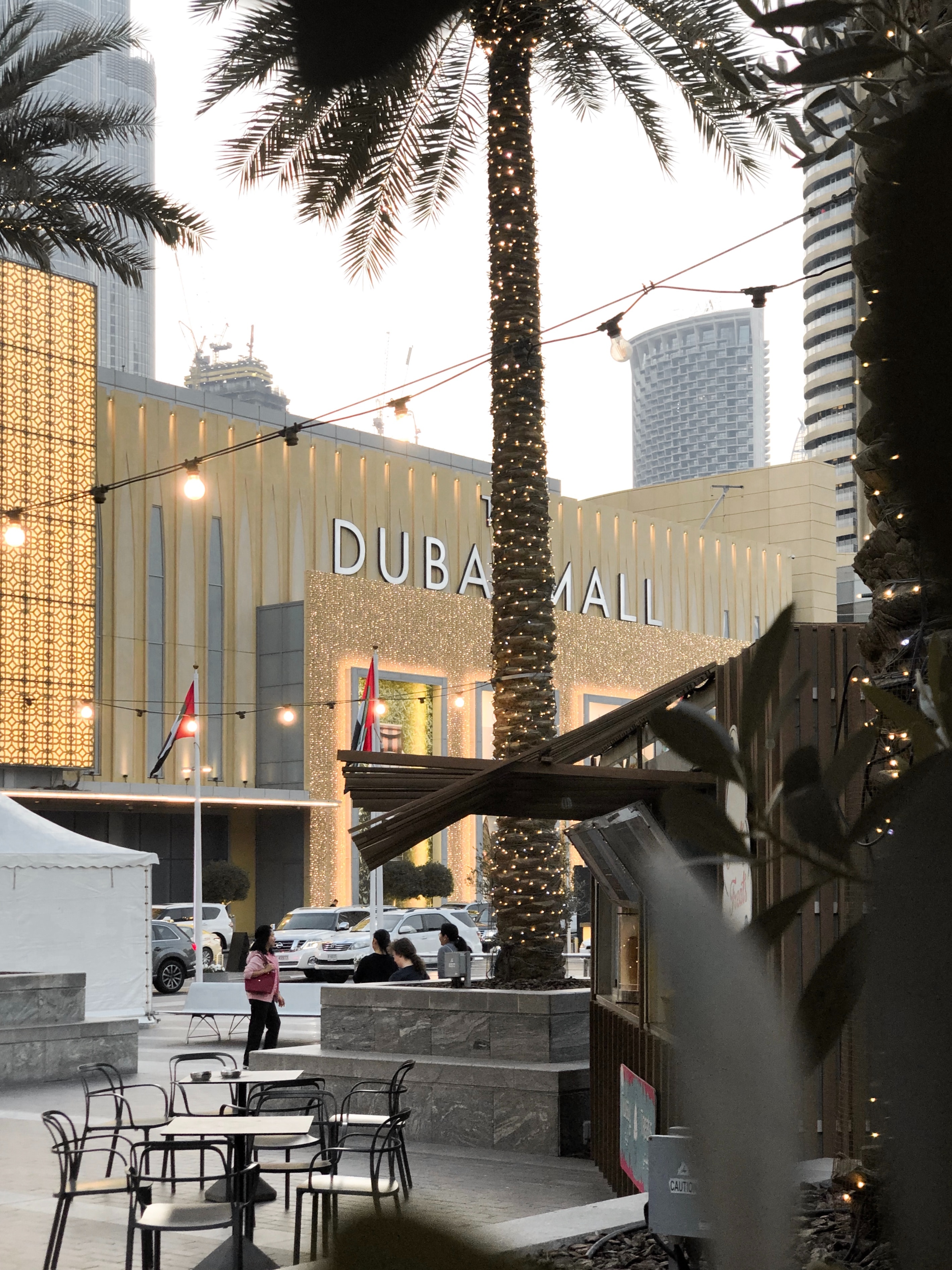
6) Cool at the ice rink in the Dubai Mall, where you can spend hours with friends on skates. It’s open on Friday and Saturday, and it's always filled with people sitting and enjoying themselves with their friends and family.

7) Make a visit to The Pointe at Palm Jumeirah, where you can take a ride on an electric catamaran. Their cruise is indeed exciting as you get to see the Dubai skyline from the waters and also enjoy the Palm Fountain when it is all lit up and impressively shooting water to about 105 metres high.
8) If you are into photography, then you certainly would want to indulge in night photography across the beautiful Dubai skyline. Gulf Photo Plus offers the opportunity to do this through its night photography workshop. You will be taken to various attractions that can be photographed under dazzling lights in different ways.
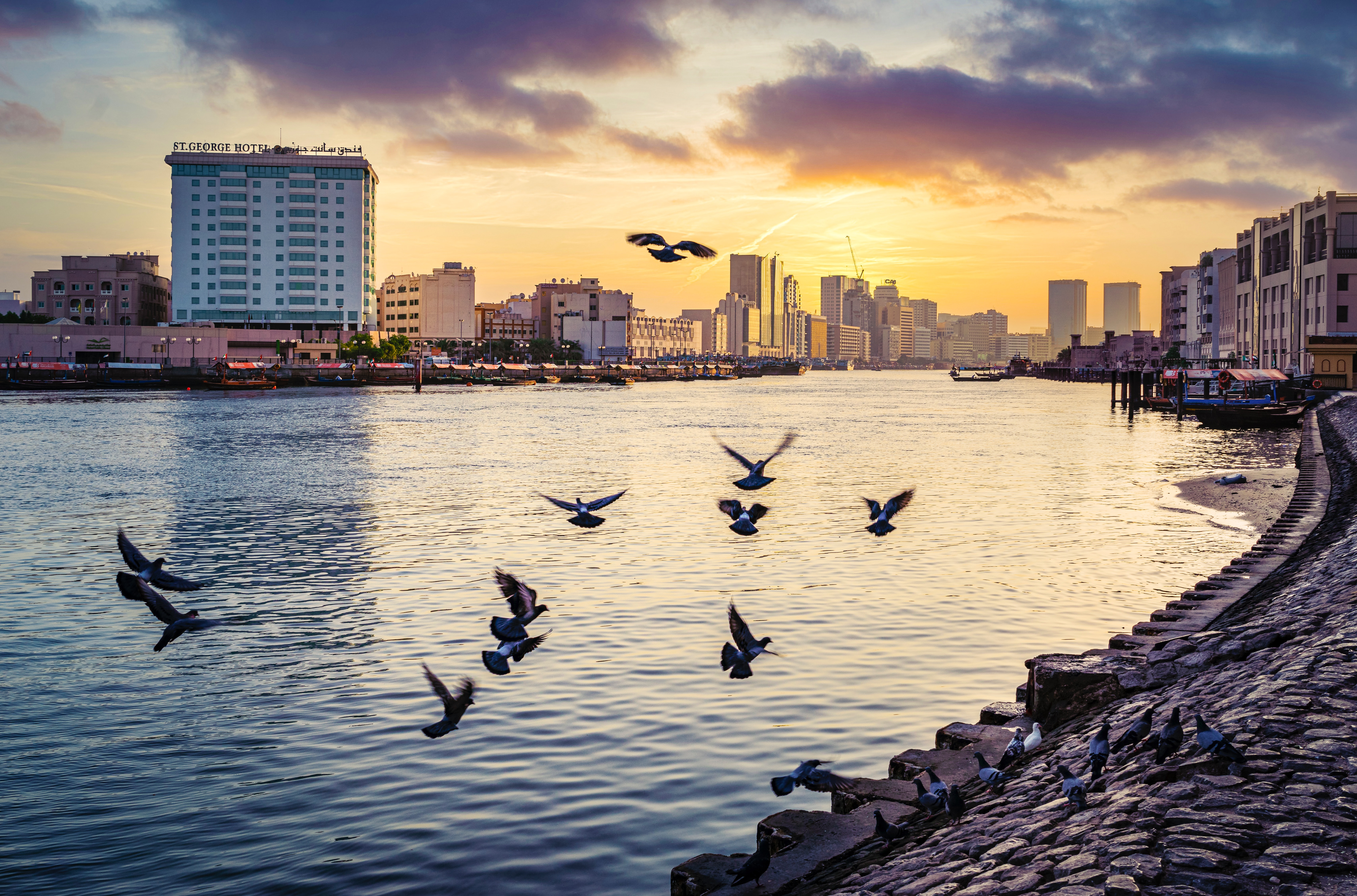
9) Book an Abra ride across Dubai Creek and enjoy viewing the lovely Dubai skyline. As the night progresses, you can see so many places lit up with different coloured lights, and the entire scene is a must to photograph.
10) How about indulging in a desert safari that gives many experiences such as quad biking, camel riding, barbeque dinners, and sand skiing? The companies that offer such experiences will pick you up at your location in the afternoon and then drop you off the next morning.
You can enjoy exploring such locations at night by opting to fly with Emirates Airlines from your country. Once you have arrived, book into a hotel and pick up those places that you must visit at night to have an exciting time here. These places can be easily reached by cab, and when you get there, you will have a fabulous experience that leaves behind lasting memories.
Tuesday, October 03, 2023
A Journey Through the Most Basketball-Obsessed Countries

Are you a big fan of basketball? If you are, this is your chance to find out about the countries that love basketball just as much as you do! Let's use this 1xbet site as a guide and go on an amazing journey together to explore some of the world's most basketball-obsessed countries. Get ready to learn about their unique cultures, all united by a shared love for this fantastic game.
1) Lithuania: A Country Full of Basketball Love
In Lithuania, everyone loves basketball. It's more than just a game. It’s a way of bringing people together. Young or old, the excitement for basketball is in everyone's heart.
What to Do in Lithuania:
a) Visit the Rytas Vilnius Arena: Experience the energy of a local basketball game and feel the strong spirit of Lithuanian fans.
b) Lithuanian Basketball Hall of Fame: Take a journey through history and honor the legends who have made Lithuania's basketball so special.
Explore Lithuania:
Discover hidden basketball treasures in Lithuania. Talk with local fans and learn about the famous games and great players that have made the country's basketball history so rich.
2) Philippines: Where Basketball Brings Everyone Together
In the Philippines, you'll find basketball everywhere, from the busy streets to the peaceful islands. The country’s basketball association, PBA, is a source of pride and unity for the community.
What to Do in the Philippines:
a) Play Pickup Basketball: Enjoy friendly games of basketball and experience the warm Filipino hospitality.
b) Attend a PBA Game: Feel the thrill of a PBA game and join in the contagious excitement of the passionate crowds.
Discover the Philippines:
Explore the world of Filipino basketball culture. See how basketball brings joy and unity to every part of Philippine life.
3) Spain: Enjoy the Thrill of Basketball
In Spain, basketball is celebrated with a lot of excitement. The Spanish league, Liga ACB, shows off the best of Spanish basketball talent.
Traveling in Spain:
a) Explore the exciting world of Spanish basketball
b) Enjoy the lively games of Liga ACB and visit famous places like the Palau Blaugrana in Barcelona
c) Talk with local fans and learn about Spain’s love for basketball
4) Australia: Where Basketball is Growing Fast
In Australia, more and more people are falling in love with basketball. The growing National Basketball League (NBL) is a sign of the nation’s increasing passion and talent for the game.
What to Do in Australia:
a) Watch an NBL Game: Dive into the world of Australian basketball and enjoy exciting NBL games.
b) Visit the Australian Basketball Hall of Fame: Walk through the history of basketball in Australia and celebrate the people who have helped basketball grow in the country.
Discover Australia:
Explore different parts of Australia’s basketball world. Find out about local programs and communities that are helping basketball grow in the country.
Conclusion: A Fun Worldwide Basketball Adventure
In this exciting journey, each country has its unique basketball story to tell. Your exploration is more than just watching games. It’s about making new friends and sharing the joy of basketball with them. The world of basketball is a big, welcoming place full of different cultures and histories.
So, let's go on this grand adventure through the world’s most basketball-obsessed countries. Enjoy the mix of experiences, stories, and friendships that the global basketball community happily shares. Let this worldwide basketball journey fill your travels with exciting adventures, fun stories, and the warm embrace of the global basketball family.
Thursday, September 14, 2023
Kallidaikurichi Anaicut: Gorgeous picnic spot nestled in the lap of nature
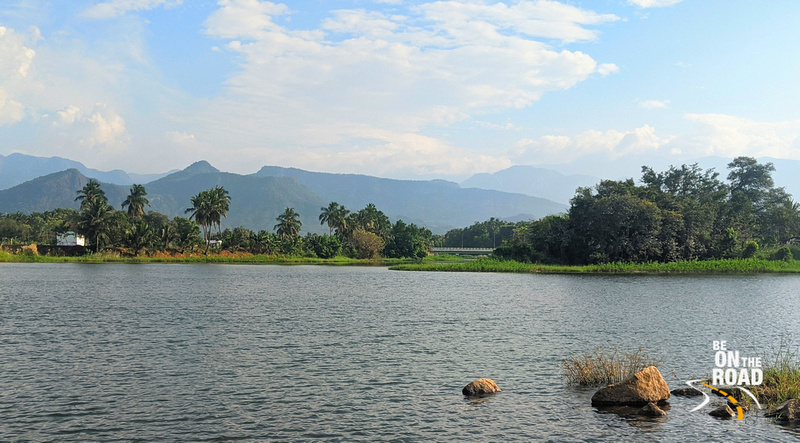
This stunning location is the confluence of the Manimuthar and Thamirabharani rivers. It is the birthplace of the Kannadigan canal that irrigates Kallidaikurichi and other downstream villages all the way till Gopalasamudram. It offers beautiful views of the Western Ghats in the background and is surrounded by lotus farms, paddy fields and trees. I am talking about the Kallidaikurichi Anaicut, a gorgeous picnic spot nestled in the lap of nature.

Located between the villages of Kattumannarkoil and Vairavikulam, the Kallidaikurichi Anaicut is a manmade barrage at the confluence of the Manimuthar and the Thamirabharani rivers. It offers sluice gates at two ends. One that lets water go into the Thamirabharani river and the other that lets the water into the Kannadigan canal that flows east towards Kallidaikurichi. This Kallidaikurichi anaicut is an essential cog in irrigating this region and also acts as a basic flood control mechanism.

You have to cross lines and lines of paddy fields, lotus farms and picture perfect villages to reach the Kallidaikurichi Anaicut and the place where you park your vehicles is the bridge with the sluice gates to the Kannadigan canal. And if this was gorgeous, wait till you cross the tree cover, climb down the steps to the canal level, walk over the narrow concrete ridge to reach the small Murugan temple located at the confluence of the Manimuthar and the Thamirabharani rivers. On one side of the temple is the hip deep water with sandy bottom while on the other side is the water gushing at high speed towards the Thamirabharani river. Both of them form great avenues for some serious fun in the water.

This location is perfect for a beautiful picnic with your family and friends. There is lush nature, year round fresh water that starts in the mountains a few kilometres upstream, a small temple, a great water based holiday destination, a serene rustic atmosphere and gorgeous scenery. I would recommend this place with many thumbs up. Only request is to carry back all your trash with you and refrain from using soap, shampoo and/or oil when you take a bath in the river as many downstream villages use this water for drinking purposes.

Best time to visit:
As most of the Anaicut area near the water is devoid of any tree cover, it is best to visit either during the early hours of the morning (6 AM to 10 AM) and late hours of the evening (4 PM to 7 PM). In case you are cooking a little bit away from the water, there are a few large trees that can give you enough shade.
It is best to avoid the rainy months between October and December as the water levels can increase significantly within a very short time duration.

How to reach there:
If you are coming from Kallidaikurichi, head west from the Adi Varaha temple, cross the vaykaal bridge, cross Thimmarajapuram, the railway gate and a few kilometres of paddy field before you reach the Anaicut.
If you are coming from Ambasamudram, you will have to cross the concrete barrage on foot from the Thamirabharani river bank and reach the Anaicut.
If you are coming from Singampetty, Manimuthar, Keela Earmarpuram or Ambasamudram, you will have to cross the Manimuthar bridge at Vairavikulam and then head east towards the lotus farms of Vairavikulam and then reach the Anaicut.

Other nearby tourist attractions:
1) Kallidaikurichi to Manimuthar Dam: A top scenic and rustic cycling route
2) Thamirabharani river at Kallidaikurichi: A great Western Ghat river to take a refreshing bath
3) The hidden gem called Kalakad Mundanthurai Tiger Reserve
4) Kallidaikurichi: The village of the saaral season
5) 1000 year old Papanasanathar Temple at Papanasam: Where you can wash all your sins away
6) Manjolai: The offbeat hill station of Tamil Nadu
7) Mannarkoil Rajagopalaswamy Temple: Magnificent 10th century temple with a Ashtanga Vimana
8) Sivasailam Temple: 1000 year old temple surrounded by the lush mountains of the Western Ghats
9) Sivasailam: One of the wettest places during the North East monsoon in India
10) Karaiyar Dam: Offbeat wildlife and nature holiday destination in India’s deep south
11) Courtallam: The herbal bath holiday destination of Tamil Nadu
12) 10th century Kailasanathar Temple at Brahmadesam
13) 10th century Valiswara temple at Thiruvaleeswaram
14) Manimuthar Falls: A great forest waterfall
15) Agastyar Falls: A great waterfall to bathe in the Western Ghats
16) Paana Theertham Falls: A hidden waterfall gem of Tamil Nadu